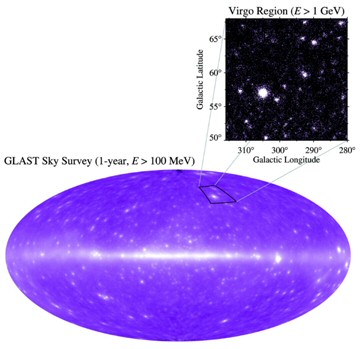Most
viable current models of formation and structure of relativistic jets
involve conversion of the gravitational energy of matter flowing onto a
central supermassive black hole. Gamma-ray flares are most likely
related to the dissipation of magnetic accretion energy or extraction
of energy from rotating black holes (c.f. Blandford and Znajek
1977). However, the conversion process itselfis not well
understood, and many questions remain about the jets, such as:
how are theycollimated and confined? What is the composition of
the jet, both in the initial and in the radiative phase?Where does the
conversion between the kinetic power of the jet into radiation take
place, and how? What role is played by relativistic
hadrons? If hadrons play a significant role, this will require
careful calculations ofparticle-particle and particle-field
interactions in the rather extreme range of particle energies
inferred for blazar jets. There are also questions about the role
of the magnetic field, such as whether the total kinetic energy of
the jet is, at least initially, dominated by Poynting flux.
The first step in answering these questions is to determine the
emission mechanisms in order to infer the content of the luminous
portions of jets. This understanding should, in turn, shed light on the
jet formation process and its connection to the accreting black
hole. Determining the emission mechanisms, whether dominated by
synchrotron self-Compton, external Compton, or hadronic processes, will
require sensitive, simultaneous multiwavelength observations. Such
observations can uncover the causal relationships between the variable
emissions in different spectral bands and provide detailed modeling of
the time-resolved, broadband spectra. The sensitivity and wide bandpass
of the LAT, coupled with well-coordinated multiwavelength campaigns,
will be essential. Broadband campaigns will measure the total jet power
as compared with accretion power, and the spectra from these
observations should revealwhether a single zone structure is sufficient
or whether multiple zones are required. Furthermore, the
content of the inner part of the jet will be tightly constrained
by broadband X-ray spectra and by temporal correlations between the
X-ray and gamma-ray variability; this is because the
radiative energy density in the vicinity of black holes in AGN can be
reliably estimated from contemporaneous broadband data, and this
circumnuclear radiation must Compton-scatter with all "cold"
charged particles contained in the jet (e.g. Sikora and Madejski
2000; Moderski et al. 2004). Finally, the detection of
anomalous gamma-ray spectral features will indicate the importance
of hadronic processes, with significant implications for the origin of
ultra-high-energy cosmic rays.

This
table summarizes
the issues to be addressed with the LAT data.. These Science
Goals
will drive the multi-wavelength observations performed in
contemporaneous/
simultaneous campaigns, which are already being actively prepared (see
the page
of the LAT Multiwavelength Group).A
more detailed document
on these Science
Goals
is
posted here.
Extragalactic
Background Light
The Extragalactic Background Light (EBL)
carries unique information regarding the galaxy formation and evolution
history. The LAT should be able to measure the EBL redshift evolution
in the
optical/UV band via the attenuation in the high-energy flux from
high-redshift blazars (Chen et al. 2004). Thanks to the large
population of such
blazars that should be detected by the LAT, one expects to be able to
disentangle the attenuation due to the EBL from intrinsic effects.
However, since
the cutoff energy will lie in the 50 GeV range, a long integration time
(~ 1 year) will be necessary.
References
Blandford, R. D. and Znajek R.L. , 1977,
MNRAS, 179, 433.
Chiang J. and Mukherjee R., 1998, ApJ 496, 752.
Chen, A., Reyes L.C., and Ritz S., 2004, ApJ 608, 686.
Dermer C. D. , 2006, ApJ, submitted (astro-ph/0605402).
Fossati G. et al., 1998, MNRAS, 299, 433.
Giommi P. et al. ,2006, A&A, 456, 911.
Hartman R.C. et al., 1999, ApJS, 123, 79.
Healley 2006
Kniffen D. A. et al., 1993, ApJ 411, 133.
Moderski R. et al. 2004, ApJ, 611, 770.
Mücke A. and Pohl M., 2000, MNRAS, 312, 177.
Sikora M. and Madejski G., 2000, ApJ, 534, 109.
Stecker F.W. and Salamon M.H., 1996, ApJ, 464, 600.
Urry C.M. and Padovani P., 1995, PASP, 107, 803.
Last updated 24
November 2006
B. Lott
